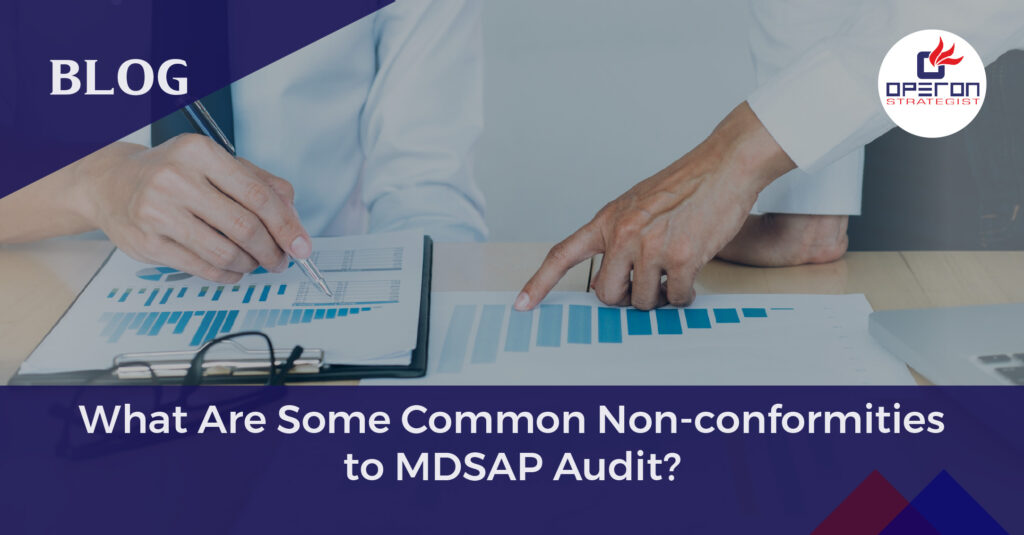MDSAP Audit
The Medical Device Single Audit Program (MDSAP) was formed by the International Medical Device Regulatory Forum (IMDRF) to adopt a global regulatory approach and promote consistency and transparency by harmonizing the program. It consists of ISO 13485:2016 and regulations and standards of 5 participating countries.
You can check out our page on MDSAP audit to learn more about it.
MDSAP observes various non-conformities while auditing. Continue reading to find out some of the common non-conformities found during MDSAP audits.
Looking For MDSAP Audit Guidance?
Let’s have a word about your project
[contact-form-7 id=”4448″ title=”Contact Form”]
Who Are the Participants in MDSAP?
MDSAP audits prove to be of great value to manufacturers as a single audit ensures compliance with the regulations of 5 different medical device markets. It is accepted by the following regulatory bodies:
- Australia (TGA: Therapeutic Goods Administration of Australia).
- Brazil (ANVISA: Brazil’s Agência Nacional de Vigilância Sanitária)
- Canada (Health CANADA)
- Japan (MHLW: Japan’s Ministry of Health, Labour and Welfare, and the Japanese Pharmaceuticals and Medical Devices Agency)
- USA (FDA: Food and Drug Administration).
Common Non-conformities to MDSAP Audits
Below are some non-conformities found while conduction audit:
Preparedness for Country specific requirements
While preparing the QMS documentation for MDSAP. The companies miss out on mentioning the country specific requirements.
Documentation errors
As per medical device experts, mostly non-conformances are found in this area. MDSAP audit will require you to demonstrate evidence of conformity to the program. Documentation is crucial to ensure this as it holds records of everything from product design to post-market activities.
Risk management
Risk management was first introduced in ISO 13485:2016 to make organizations consider the risks involved in the design, development and manufacturing phases. MDSAP prioritizes risk and makes it an underlying element of all processes.
Purchase and supply control
With MDSAP’s emphasis on purchasing, it has now become an underlying process for everything. You will now have to consider how purchasing will affect your supply chain and further the delivery of product to end customers.
Tips for Successful MDSAP Audit
Organize your documents
Documents are crucial at all stages hence all the documents must be organized and made accessible for a successful audit. The audits are scheduled activity and the auditing organization (AO) will visit the site only once so make sure you are ready with all the documents before the audit.
Perform Gap analysis and internal audits
The auditing organizations and manufacturers who have gone through the MDSAP audits agree that using a MDSAP companion document is the best way to prepare for the audit. An MDSAP companion document will help you create a gap analysis and perform an effective internal audit. The companion document is a handy supplement for manufacturers and will help them understand what areas will auditors focus on.
Use the MDSAP audit model to determine AO needs
MDSAP audit model is an AO’s guide with all the information needed for the audit. All the questions that an AO will ask ar listed in this comprehensive guide. And each question is aligned with relevant sections of ISO 13485:2016 and other specific requirements of participating medical device regulatories.
You should check our blog on preparing for an MDSAP audit if its your first audit.
Operon Strategist Can Help You Prepare for MDSAP Audit
MDSAP audits will make your medical device compliance-ready at the international level and in 5 prominent medical device markets. Contact us for the right guidance for your MDSAP audit.
Operon Strategist is a medical device regulatory consulting firm, that provides CDSCO medical device registration consultancy services and ISO 13485 certification consultancy services. Contact us today and let our expert team guide you toward successful regulatory approvals.




